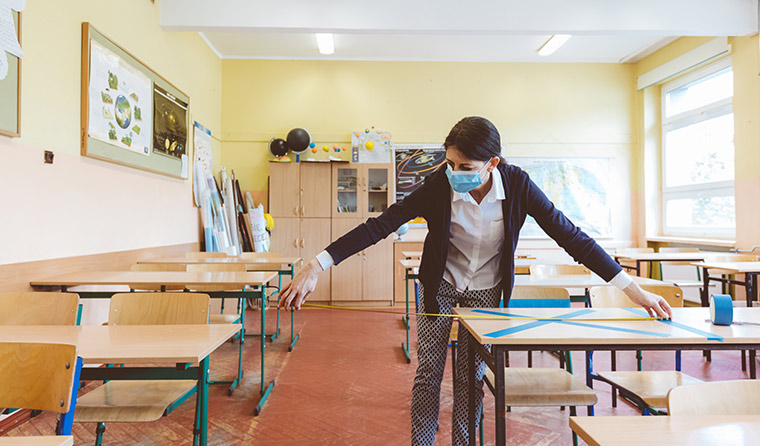News
Study shows older children may spread coronavirus as much as adults
The finding comes as many Australia children return to school, though some experts have expressed reservations about the results.
 At the time of publication, 12 schools in Victoria were closed for deep cleaning due to coronavirus.
At the time of publication, 12 schools in Victoria were closed for deep cleaning due to coronavirus.
Students across the country have either already returned to classrooms or are preparing to do so this week.
The vast majority will do so in person, as the Australian Health Protection Principle Committee (AHPPC) has deemed the risk of transmission ‘relatively low’; however, a new observational study has suggested children aged 10–19 spread coronavirus just as much as adults.
The paper, published in Emerging Infectious Diseases, identified 5706 people in South Korea who were the first to report coronavirus symptoms in their households and then traced 59,073 contacts of these ‘index cases’.
Overall, nearly 12% of more than 10,590 household contacts were found to have COVID-19, while only 1.9% of 48,481 non-household contacts tested positive to the diseases.
When divided into age groups, index cases aged 10–19 reported the highest rate of household transmission – 18.6%.
While the researchers conceded there were gaps that limited the conclusions people should draw from their findings, it was described as ‘one of the best studies we’ve had to date’ on the issue by Harvard Global Health Institute director Professor Ashish Jha.
But Dr James Best, Chair of the RACGP Specific Interests Child and Young Person’s Health network, told newsGP that while the study is ‘interesting’, it only provides part of the picture.
‘There are a lot of variables here – [for example], it was done during a lockdown situation where children were at home – so it needs to be interpreted with caution,’ he said.
‘Certainly in terms of drawing conclusions about whether we should open or close schools, it’s only a small part of the information that goes into making such a decision.’
ANU infectious diseases physician and microbiologist Professor Peter Collignon also told newsGP he has some reservations about the findings.
‘My issue about that study, at least from the figures I’ve seen, is that they don’t break them up by year, and 16 and 17-year-olds are quite different to 12-year-olds,’ he said.
‘All the evidence is that children under the age of 15 do seem to record fewer infections than people in their 20s and 30s, who are the major group.
‘Secondly, I think you need to take into account the numbers, rather than just the percentage.
‘The numbers are much smaller than the next age group of 20–40-year-olds, which … has shown to be the group getting the most infections and spreading the most, but having the least amount of complications.’
 Schools around Australia are preparing to welcome children back into classrooms.
Schools around Australia are preparing to welcome children back into classrooms.
While most classrooms around Australia remain open, the majority of students in Victoria from prep to Year 10 will do remote learning until at least 19 August. At the time of publication on 20 July, 12 schools in the state are currently closed for deep cleaning due to outbreaks, while one of the largest clusters to recently emerge has been linked to Al-Taqwa College, which has recorded 173 cases.
Students who attend class in person, including Year 11 and 12 students and those who are not able to be supervised at home, will be required to wear masks. Masks will not be mandatory for teachers while they are teaching students, but the government has said they should be worn at other times.
However, Professor Collignon believes Victoria’s cut off is ‘the wrong way around’ and that children 15 and over should be remote learning instead.
‘There really isn’t a good reason to shut primary schools and infant schools. Because in terms of total transmission they are not very significant, but it has tremendous educational and social implications,’ he said.
‘[It’s] not that you won’t get any spread – they can get it – but mainly it’s coming in from their homes to them, and they’re being found more often in schools because they do more testing in schools.’
According to Professor Collignon, the greater risk at schools stems from outside the classroom.
‘Teacher-to-teacher transmission is much more common than children-to-teacher transmission, which is the reason that in staff rooms you have to physically distance or wear masks,’ he said
‘Luckily, [the risk is] not with young children, relatively speaking … but adults.
‘Your friends and the people in your crowded staff room or handover room etcetera is where most of the spreading proportionally seems to be occurring, and it’s from adults to adults much more than children to adults.
‘It’s similar to medical staff – mostly it’s not patients to medical staff, and it’s not students to teachers it. It’s actually your own peer group.’
Log in below to join the conversation.
children coronavirus COVID-19 schools
newsGP weekly poll
Health practitioners found guilty of sexual misconduct will soon have the finding permanently recorded on their public register record. Do you support this change?